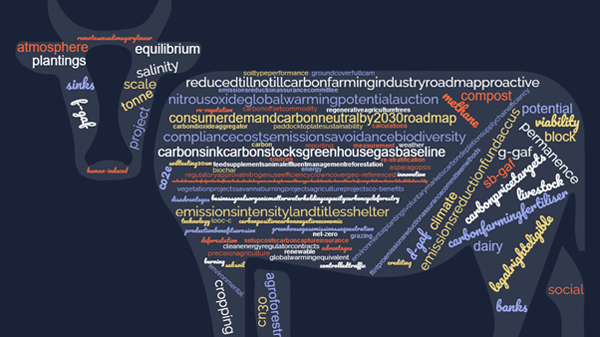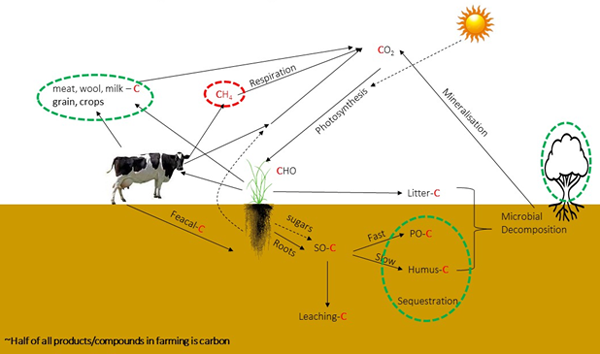Leanne Sherriff
Our word art cow illustrates the enormous amount of noise around carbon in agriculture at the moment. Many in industry and government would have us believe that carbon is the next big thing for agriculture, and we need to act NOW. But carbon is a hugely complex topic, so it’s worth pausing, taking a breath and unpacking things a little to work out what’s hot air and what’s based on robust science. As a starting point, climate change and carbon do offer opportunities and risks for agriculture, although what’s what will differ for different industries, regions and individual businesses.

Greenhouse gases and agriculture
Agricultural activities release greenhouse gases. Agricultural contributes 16% of Australia’s total Green House Gass (GHG) emissions, of which the three key gases are as follows.

The carbon cycle figure shows how the natural carbon cycle works in agriculture. Carbon changes form at different points of the cycle. For example cows eat grass and convert the carbohydrates into a product (meat or milk) that contains carbon and releases methane as a by-product. The carbon cycle isn’t balanced from a GHG perspective because of the different global warming potential (GWP) of carbon products (methane) (Table 1). While carbon is one of the building blocks of life (think protein, carbohydrates), it can have negative impacts in some forms (e.g. gases that trap excess radiant energy with the atmosphere).
The carbon cycle figure also shows how carbon can be captured and stored by agricultural activities - in the soil as humus and in trees

Opportunities for agriculture
Agriculture is in a unique position in managing greenhouse gas emissions. There is an opportunity to reduce emissions (and at the same time improve productivity) and to capitalise on the potential to store carbon in soils and trees through changed management. Practices that store carbon provide co-benefits that help to make production systems more resilient (e.g. soil water retention, nutrient cycling, biodiversity). Climate change impacts are most likely to be challenging for agriculture (e.g. increased temperatures, changes to rainfall patterns). Doing our best to reduce emissions of GHGs will help to minimise the impacts of climate change.
Carbon farming
Carbon farming is the process of changing agricultural practices or land use to increase the amount of carbon stored in soil or vegetation and reduce greenhouse gas emissions from livestock, soil or vegetation. Carbon farming may provide additional business benefits, including:
- Additional income stream. Using approved management practices may provide an opportunity through carbon trading for a long-term sustainable income stream. It also provides an opportunity for sustainable income generation from a range of land classes.
- Strategic and competitive market positioning. There is increasing demand for carbon-friendly products (carbon neutral, low carbon), and some industries have carbon neutral targets (e.g. Meat & Livestock Australia’s CN30 goal).
Carbon stocks are not infinite and can only be counted once. If you make the decision to trade carbon, depending on what your baseline carbon balance is, you may forgo future opportunities to trade your products as carbon neutral. Hence this decision should not be taken lightly.
Where to start
The best place to start is to measure where you’re at now and identify the opportunities for your business to reduce emissions or improve carbon capture and storage. You also need to have a clear idea of your business goals and capability to ensure that whatever carbon farming strategy you decide on, it will be the correct long-term fit for your business. Carbon or GHG calculators are available for most industries. You also need to do your homework on any potential carbon trading project – be sure that the potential carbon sequestration targets are realistic and based on sound science and clearly understand the legal implications and the costs associated with implementing carbon projects. While the carbon space does present some new opportunities for agriculture, it also presents some challenges and risks, which need to be carefully thought through and managed.
Pinion Advisory’s carbon and climate change team works with clients to provide independent, scientifically sound, business-focused support and advice to navigate the world of carbon. We have an in-depth understanding of on-farm production systems and carbon and GHG emissions, enabling informed recommendations to increase productivity and profitability and improve sustainability. We do the homework for you.
For more information on our services and on carbon more generally, click here.